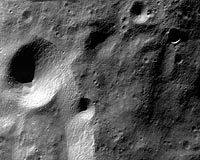 |
Cleveland OH (SPX) Sep 29, 2009 Flying high over the Gulf of Mexico, researchers from NASA and Case Western Reserve University found a key to unlocking oxygen from the surface of the moon. The celestial body has no atmosphere like Earth's, holding the precious element just a breath away. But, oxygen to breathe, grow food, create water and burn rocket fuel - to make a space outpost a reality - is trapped in its soils. Scientists from NASA and Case Western Reserve are designing and testing components of an oxygen generator that would extract the element from silicon dioxide and metal oxides in the ground. They have designed sifters needed to produce a consistent supply of oxides. But, how would the sifters work in the moon's gravity, which is about one-sixth as strong as the Earth's? To find out, Katie Fromwiller, a senior civil engineering student, and Julie Kleinhenz, an assistant research professor of aerospace and mechanical engineering, spent two days flying in high arcs off the Texas coast last month. This was Fromwiller's first trip on the plane, which space researchers refer to as the "vomit comet," due to the unsettling ride. Inside the plane, the pull of gravity approximated the moon's weak gravity during the rapid drop in each arc. The riders felt twice the pull of the Earth's gravity on the way back up. During two runs, they floated in zero gravity. "Not in a million years would I have ever expected to do something like this with NASA," said Fromwiller, who is also a member of the Case Western Reserve women's soccer team and the Voices of Glory chorus. But, the space agency wants to learn how to work with the soils, and Fromwiller's focus is geotechnical engineering. She teamed with Kleinhenz, a veteran of more than 1,000 hours on the vomit comet. "It was as if they were working on the moon, 20 seconds at a time," said David Zeng, Frank H. Neff Professor and Chair of Civil Engineering from the Case School of Engineering and one of the principal investigators of the study. NASA engineers were testing other components of the oxygen generator on the same flight. NASA, Kleinhenz explained, has plans to build a system that includes a rover that would dig, carry and dump moon soil into a hopper or holding vessel. Sifters would separate particles by size, collecting those that can be converted most efficiently. The particles can also be separated by composition. For example, an electrostatic charger can be used to isolate iron oxides from other soil materials. The wanted particles would then be blown into a reactor with hydrogen and heated to 2,000 degrees Fahrenheit. At this time, the oxygen released from the oxides would attach to the hydrogen and be collected. While in flight, the pair tested two kinds of devices, a vibro-sieve and a sifter. As the plane reached lunar gravity, Fromwiller switched on a vibration table that shook a sieve, similar to a perforated pan used to pan for gold. As on Earth, the process worked. Kleinhenz worked a sifter that operates much like a flour sifter. It, too, was able to separate particles in low gravity. Zeng and his team are continuing to analyze data produced over the two days. Ultimately, NASA will decide which kind of device to use in the oxygen generator. Funding for the continued project may be in jeopardy now that a White House advisory panel concluded NASA would need an additional $3 billion annually to return to the moon by 2020 and the funding might be better used elsewhere. But, the panel also said Mars should be the ultimate destination for manned missions. "The technology is useful outside the lunar system," Kleinhenz said. "It's applicable to Mars."
Share This Article With Planet Earth
Related Links Case Western Reserve University Mars News and Information at MarsDaily.com Lunar Dreams and more
 Extracting Water From Moon Possible: Indian Scientist
Extracting Water From Moon Possible: Indian ScientistNew Delhi, India (XNA) Sep 28, 2009 Indian Space Research Organization (ISRO) Chairman Madhavan Nair on Friday claimed that it is possible to extract water from the Moon just a few hours after it was confirmed that water was present on the lunar surface. Offering a glimmer of hope to the scientific community that water found on the Moon could be used, Nair said, "It's possible to extract ... read more |
|
| The content herein, unless otherwise known to be public domain, are Copyright 1995-2009 - SpaceDaily. AFP and UPI Wire Stories are copyright Agence France-Presse and United Press International. ESA Portal Reports are copyright European Space Agency. All NASA sourced material is public domain. Additional copyrights may apply in whole or part to other bona fide parties. Advertising does not imply endorsement,agreement or approval of any opinions, statements or information provided by SpaceDaily on any Web page published or hosted by SpaceDaily. Privacy Statement |